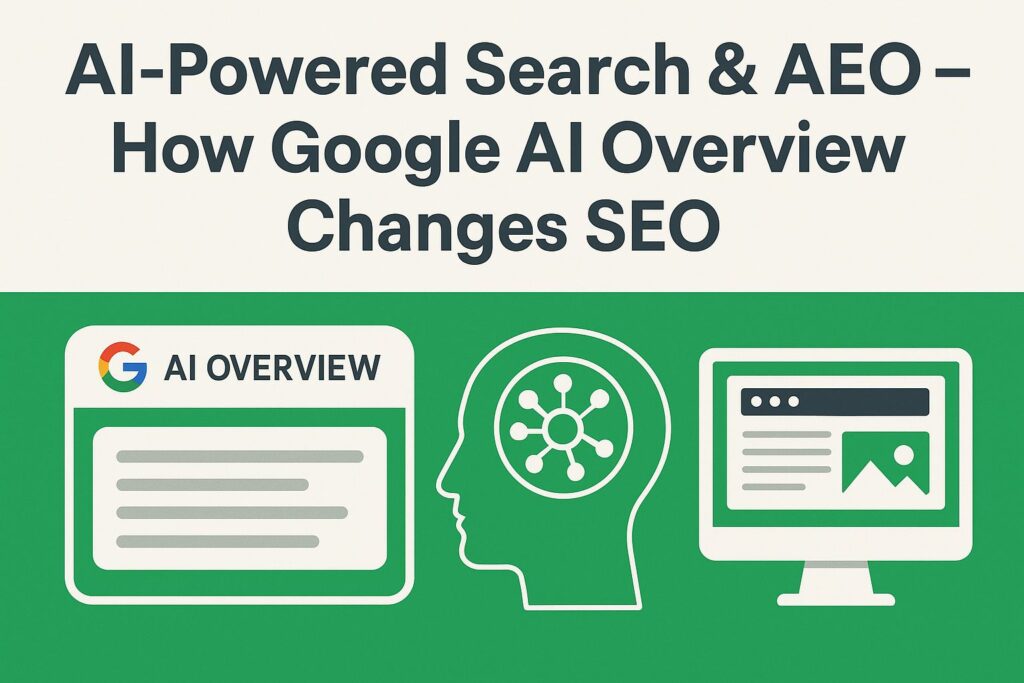Introduction
The world of search is changing — again.
After years of optimizing for keywords and backlinks, the new era of AI-powered search is here, led by Google’s latest innovation: AI Overview.
In 2025, this shift marks the rise of AEO (Answer Engine Optimization) — a new discipline where brands must optimize not just for search rankings, but for AI-generated answers.
Let’s explore how AI Overview works, what it means for SEO, and how you can adapt your strategy to stay ahead.
What Is Google’s AI Overview?
Google AI Overview (previously called Search Generative Experience or SGE) is Google’s new AI-driven feature that provides concise, context-aware answers at the top of search results.
Instead of a list of links, users now see AI-generated summaries — pulling insights from multiple credible sources.
For example:
If you search “best ways to learn Python in 2025,” Google’s AI Overview gives you a summarized guide, learning paths, and recommendations — without needing to click a link.
This means AI is now the middle layer between users and your website.
From SEO to AEO: The New Optimization Game
Traditional SEO (Search Engine Optimization) focused on ranking in blue links.
AEO (Answer Engine Optimization) focuses on earning visibility inside AI-generated answers.
In short:
You’re no longer optimizing for Google’s index — you’re optimizing for Google’s AI.
How AI-Powered Search Works
AI Overview uses Large Language Models (LLMs) and multimodal AI to:
- Analyze search intent
- Retrieve relevant sources
- Generate summarized, conversational responses
- Cite links it used for the summary
Your goal as a creator or business?
Ensure your content is structured, factual, and authoritative enough to be used by the AI system in those summaries.
AEO Best Practices for 2025
Here’s how you can make your content AI Overview-friendly while maintaining strong SEO foundations:
1. 🧭 Focus on Clear, Contextual Answers
Write your content as if you’re answering a question directly — use conversational yet informative language.
Example: Start paragraphs with “Here’s how…”, “Let’s explore…”, or “In short…”.
2. 📚 Use Structured Data & Schema
Add schema markup (FAQ, HowTo, Product) so Google can better understand your content context.
3. 💬 Target Conversational Queries
AI Overview responds best to natural, question-based searches like:
- “What is AEO?”
- “How does AI Overview affect SEO?”
- “How to optimize content for AI search?”
4. ⚡ Prioritize Expertise and Source Credibility
Google’s AI prefers sources with E-E-A-T (Experience, Expertise, Authoritativeness, Trustworthiness) signals.
Add author bios, references, and factual insights.
5. 🔗 Use Short, Scannable Sentences
AI models read and summarize structured, concise text more effectively than long, complex paragraphs.
6. 🧠 Leverage Multimodal Content
AI Overview integrates text, video, and images.
Add infographics, tutorial videos, or audio snippets to strengthen your content’s presence in AI summaries.
The Future of SEO in an AI World
AI-powered search doesn’t kill SEO — it evolves it.
Instead of chasing rankings, marketers now aim to:
- Be cited as a trusted source in AI summaries
- Deliver direct, value-driven answers
- Build AI-recognizable authority in their niche
By 2026, websites optimized for AEO will outperform traditional ones in both traffic and visibility.
What Does This Mean for Businesses?
If your content isn’t AI Overview–ready, you risk disappearing from top results — even if your SEO is strong.
Businesses that adapt will benefit from:
- Higher visibility in AI summaries
- More clicks from cited references
- Stronger brand authority in conversational search
Those that don’t may find their traffic quietly shifting — not to competitors, but to Google’s AI itself.
Conclusion
The rise of AI-powered search marks one of the biggest shifts in digital marketing since the birth of SEO.
With Google AI Overview, the focus moves from ranking pages to powering answers.
And that’s where AEO (Answer Engine Optimization) becomes your competitive edge.
The future of search isn’t about being found — it’s about being referenced by AI.



